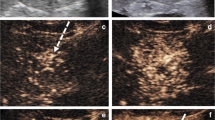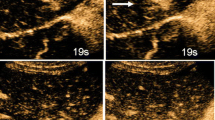Abstract
Objectives
To assess the contrast-enhanced ultrasound (CEUS) frequencies of centrifugal enhancement, spoke-wheel sign and central scar in focal nodular hyperplasia (FNH) as a function of lesion size.
Methods
Ninety-four FNHs were retrospectively reviewed to assess their largest diameter and enhancement pattern, including centrifugal enhancement from one central artery, spoke-wheel sign, diffuse or centripetal enhancement, central scar and late-phase washout.
Results
Mean FNH-lesion size was 3.7 ± 2.1 cm. Only 43.6 % of FNHs had centrifugal enhancement, with a spoke-wheel pattern (23.4 %) or without (20.2 %), while 56.4 % showed diffuse or centripetal enhancement. Centrifugal enhancement was observed in 73.9 % of FNHs ≤3.1 cm and 14.6 % of FNHs >3.1 cm (P < 10–4). Size and frequency of centrifugal enhancement were negatively correlated (r = –0.57, P < 10–4). The spoke-wheel pattern was also seen more frequently in smaller (37 %) than in larger FNHs (10.4 %) (P < 10–3). Late-phase washout was described in 5.3 % of FNHs and was not size-dependent. Lesions with a central scar were larger than those without, respectively, 5.7 ± 1.7 and 3.6 ± 2.0 cm (P = 0.012).
Conclusions
Typical centrifugal enhancement yielding a confident FNH diagnosis is seen significantly more frequently when the lesion is ≤3.1 cm.
Key Points
• CEUS yields confident diagnoses of FNHs ≤3.1 cm
• The larger the FNH, the lower the diagnostic sensitivity of CEUS
• Final diagnosis of FNHs >3.1 cm should be obtained with MRI not CEUS






Similar content being viewed by others
References
Wanless IR, Mawdsley C, Adams R (1985) On the pathogenesis of focal nodular hyperplasia of the liver. Hepatology 5:1194–1200
Cherqui D, Rahmouni A, Charlotte F et al (1995) Management of focal nodular hyperplasia and hepatocellular adenoma in young women: a series of 41 patients with clinical, radiological, and pathological correlations. Hepatology 22:1674–1681
Herman P, Pugliese V, Machado MA et al (2000) Hepatic adenoma and focal nodular hyperplasia: differential diagnosis and treatment. World J Surg 24:372–376
Vilgrain V, Flejou JF, Arrive L et al (1992) Focal nodular hyperplasia of the liver: MR imaging and pathologic correlation in 37 patients. Radiology 184:699–703
Bernatik T, Seitz K, Blank W, Schuler A, Dietrich CF, Strobel D (2010) Unclear focal liver lesions in contrast-enhanced ultrasonography—lessons to be learned from the DEGUM multicenter study for the characterization of liver tumors. Ultraschall Med 31:577–581
Bleuzen A, Tranquart F (2004) Incidental liver lesions: diagnostic value of cadence contrast pulse sequencing (CPS) and SonoVue. Eur Radiol 14:P53–P62
Tranquart F, Bleuzen A, Tchuenbou J (2004) Contrast ultrasound imaging in focal liver lesions: diagnostic value and guidelines. J Radiol 85:680–689
Kim TK, Jang HJ, Burns PN, Murphy-Lavallee J, Wilson SR (2008) Focal nodular hyperplasia and hepatic adenoma: differentiation with low-mechanical–index contrast-enhanced sonography. AJR Am J Roentgenol 190:58–66
Bartolotta TV, Taibbi A, Matranga D, Malizia G, Lagalla R, Midiri M (2010) Hepatic focal nodular hyperplasia: contrast-enhanced ultrasound findings with emphasis on lesion size, depth and liver echogenicity. Eur Radiol 20:2248–2256
Ungermann L, Elias P, Zizka J, Ryska P, Klzo L (2007) Focal nodular hyperplasia: spoke-wheel arterial pattern and other signs on dynamic contrast-enhanced ultrasonography. Eur J Radiol 63:290–294
Wang W, Chen LD, Lu MD et al (2013) Contrast-enhanced ultrasound features of histologically proven focal nodular hyperplasia: diagnostic performance compared with contrast-enhanced CT. Eur Radiol 23:2546–2554
Hussain SM, Terkivatan T, Zondervan PE et al (2004) Focal nodular hyperplasia: findings at state-of-the-art MR imaging, US, CT, and pathologic analysis. Radiographics 24:3–17, discussion 18–19
Claudon M, Cosgrove D, Albrecht T et al (2008) Guidelines and good clinical practice recommendations for contrast enhanced ultrasound (CEUS)—update 2008. Ultraschall Med 29:28–44
Westwood M, Joore M, Grutters J et al (2013) Contrast-enhanced ultrasound using SonoVue® (sulphur hexafluoride microbubbles) compared with contrast-enhanced computed tomography and contrast-enhanced magnetic resonance imaging for the characterisation of focal liver lesions and detection of liver metastases: a systematic review and cost-effectiveness analysis. Health Technol Assess 17:1–243
Bartolotta TV, Taibbi A, Brancatelli G et al (2014) Imaging findings of hepatic focal nodular hyperplasia in men and women: are they really different? Radiol Med 119:222–230
Soussan M, Aube C, Bahrami S, Boursier J, Valla DC, Vilgrain V (2010) Incidental focal solid liver lesions: diagnostic performance of contrast-enhanced ultrasound and MR imaging. Eur Radiol 20:1715–1725
Acknowledgments
The scientific guarantor of this publication is Oliver Lucidarme. The authors of this manuscript declare a relationship with the following company: Oliver Lucidarme is occasionally paid by Bracco Imaging France (the manufacturer of SonoVue) to organise teaching a session on contrast-enhanced imaging in liver. The other authors of this manuscript declare no relationships with any companies, whose products or services may be related to the subject matter of the article. The authors state that this work has not received any funding. One of the authors has significant statistical expertise (Mathilde Wagner) and no complex statistical methods were necessary for this paper. Institutional Review Board approval was not required because it is a retrospective study concerning the 10 past years. Written informed consent was not required for this study because it is a retrospective study concerning US exams that were regularly performed in clinical routine. In this case, an oral consent given by the patient is only required. None of the study subjects or cohorts has been previously reported.
Methodology: retrospective, diagnostic study/observational, multicentre study.
Author information
Authors and Affiliations
Corresponding author
Electronic supplementary material
Below is the link to the electronic supplementary material.
(AVI 15.5 mb)
(MPEG 8.22 mb)
(AVI 8.21 mb)
Rights and permissions
About this article
Cite this article
Bertin, C., Egels, S., Wagner, M. et al. Contrast-enhanced ultrasound of focal nodular hyperplasia: a matter of size. Eur Radiol 24, 2561–2571 (2014). https://doi.org/10.1007/s00330-014-3280-0
Received:
Revised:
Accepted:
Published:
Issue Date:
DOI: https://doi.org/10.1007/s00330-014-3280-0




